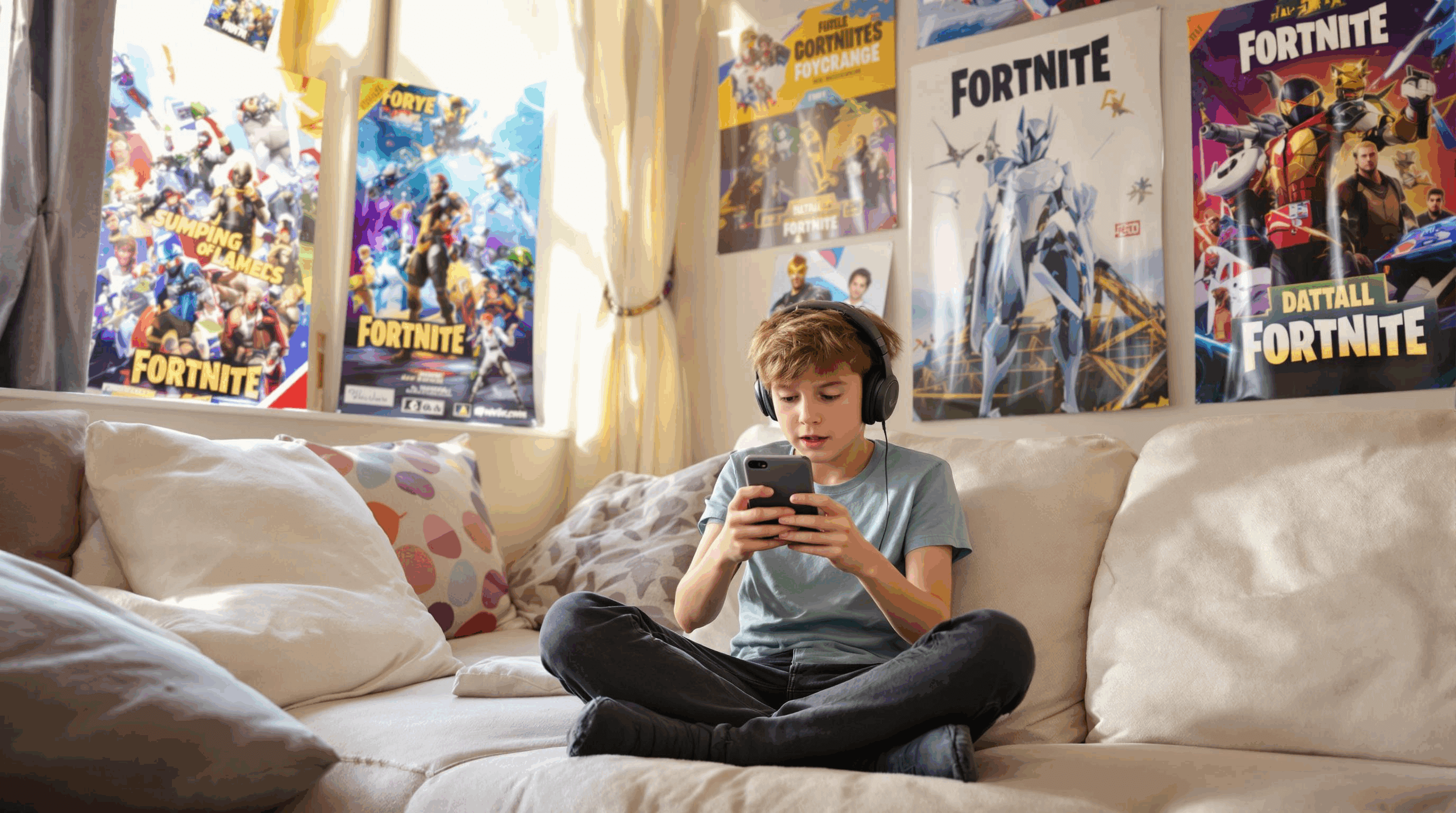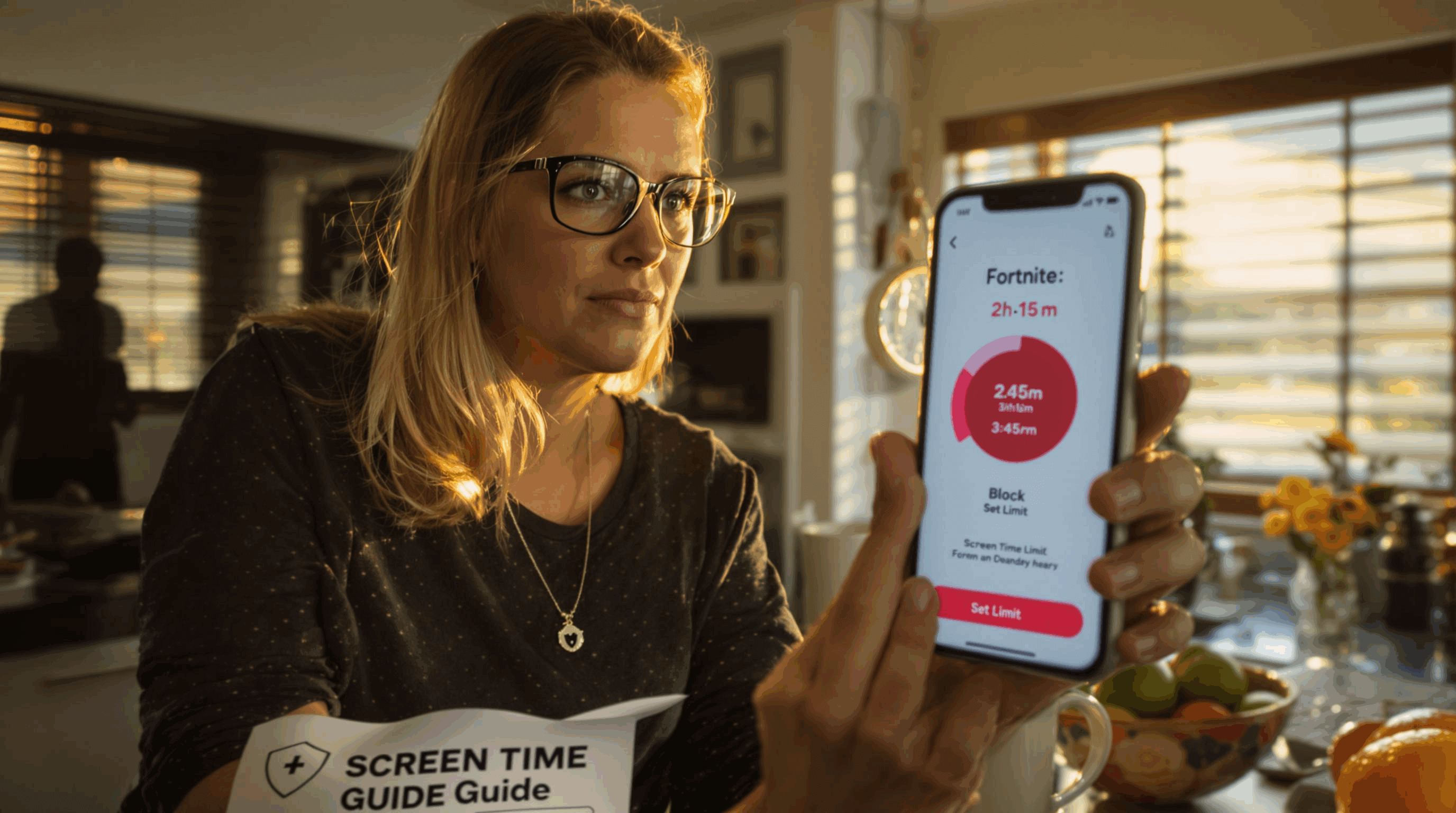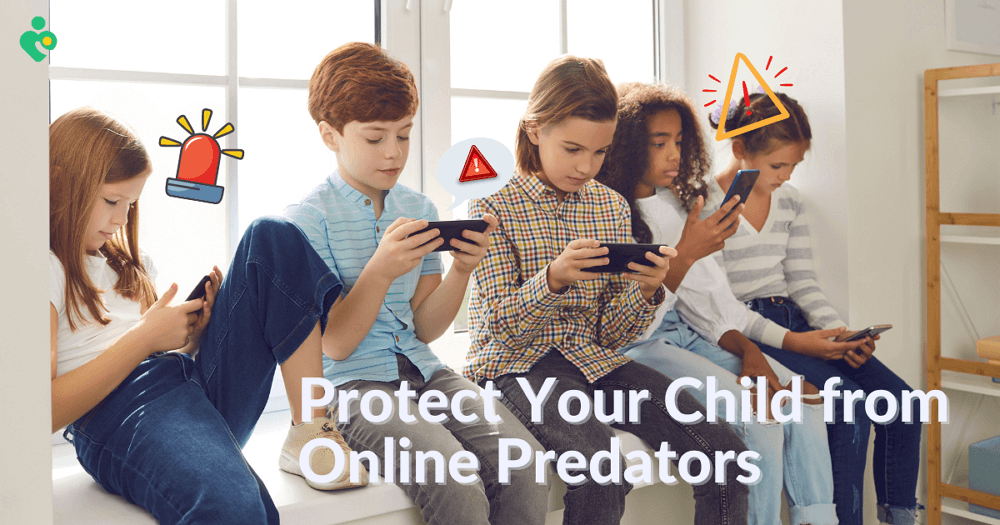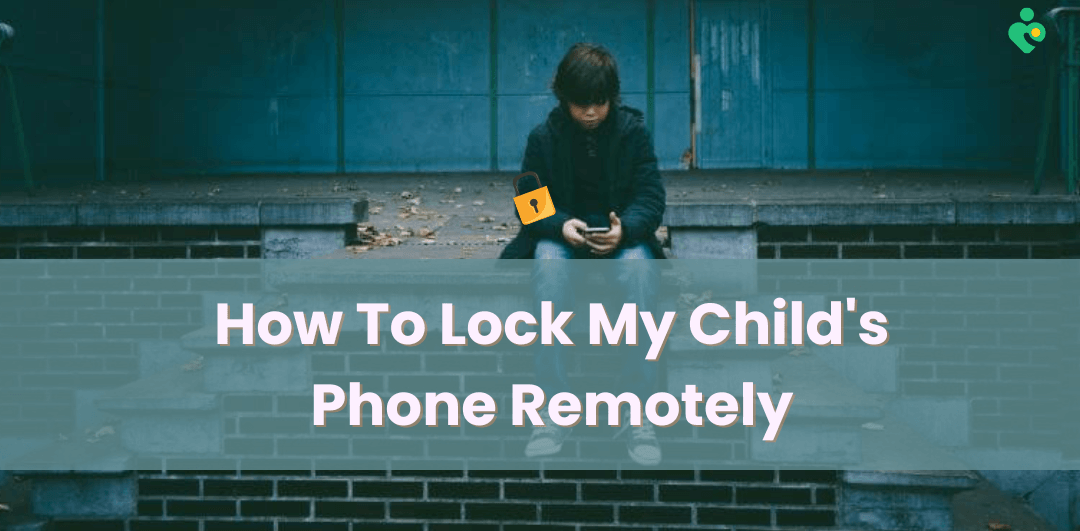I still remember the day my 11-year-old son burst through the front door after school, practically vibrating with excitement. "Mom, can I PLEASE download Fortnite? Everyone in my class plays it!" His eyes were wide with anticipation, and I could feel the weight of my impending decision.
As both a parent of two gaming-enthusiastic children and a digital safety consultant for the past 10 years, I've found myself straddling two worlds. I understand the legitimate concerns parents have about online gaming, but I also recognize the social importance these virtual spaces hold for today's youth.

What followed was my three-year journey navigating the colorful, sometimes controversial world of Fortnite—a journey that taught me there are no simple answers to the question: "Is Fortnite safe for kids?"
What Makes Fortnite So Popular Among Children?
Since its 2017 release, Fortnite has exploded to over 350 million registered players worldwide. Its free-to-play model removes financial barriers to entry, while its Battle Royale mode—where 100 players fight until only one remains—creates an addictive loop of high-stakes competition and the thrill of potential victory.
During the pandemic lockdowns, I watched as Fortnite transformed from merely a game into my children's primary social outlet. My son would coordinate with school friends to "meet" in Fortnite, where they would chat, strategize, and share experiences while playing. For many kids, including mine, Fortnite became their digital playground—a virtual space where they could hang out when physical gatherings weren't possible.
But beneath the colorful exterior and social benefits lie several concerns that deserve serious consideration. After helping dozens of families navigate these waters through my consulting work, I've developed a nuanced perspective on both the benefits and risks of this gaming phenomenon.
Key Potential Risks of Fortnite
The Addictive Design: When "Just One More Game" Becomes a Problem
"It's 10:30 PM on a school night," I said firmly, standing in my son's doorway.
"Just five more minutes, Mom! I'm in the top ten!" he pleaded, eyes never leaving the screen.
"That's what you said thirty minutes ago," I reminded him.
This exchange—familiar to countless parents—highlights one of Fortnite's most insidious risks: its masterfully engineered addictive design elements.
The Real-World Impact of Excessive Gaming
The research backs up what I've observed in my own home and in the families I counsel. A 2019 study published in the Journal of Behavioral Addictions found approximately 9% of young Fortnite players exhibited signs of problematic usage—a statistic that represents millions of children worldwide.
I witnessed my son's transformation during his initial Fortnite phase: declining grades, irritability when asked to disconnect, and a shrinking interest in previously enjoyed activities like soccer and drawing. The dark circles under his eyes told the story his words wouldn't: he was staying up late playing and watching Fortnite streams when he should have been sleeping.
The V-Bucks Trap: How Fortnite Encourages Spending
I'll never forget checking my credit card statement and discovering a string of unfamiliar charges totaling $120. When confronted, my son tearfully admitted purchasing V-Bucks—Fortnite's in-game currency—for a collection of character skins and emotes.
"But Dad, the Midas skin was limited edition! Everyone at school has it!"
This incident opened my eyes to Fortnite's sophisticated monetization strategy, which I now consider one of its most problematic aspects for young players.
While Fortnite is technically "free-to-play," its business model relies on creating constant desire for cosmetic items that have no impact on gameplay but enormous impact on social status within the game's community. The game generated over $5.8 billion in revenue in 2021 alone—mostly from these "optional" purchases.
The Hidden Costs of "Free" Gaming
Through my consulting work, I've encountered truly heartbreaking stories. One single mother described how her 13-year-old son emptied her emergency savings account—$1,200 meant for potential medical expenses—on Fortnite purchases over three months. The child had memorized her payment information after watching her enter it once.
The psychological tactics employed are sophisticated: limited-time offers create urgency, while the social pressure to own certain cosmetics is intense among peer groups. I've sat with children who described being mocked or excluded from groups for having a "default skin" (the free character appearance given to new players).
What's particularly insidious is how these mechanics exploit children's developmental vulnerabilities. Young people haven't fully developed impulse control or long-term financial thinking, making them particularly susceptible to these manipulative tactics.
Stranger Danger in the Digital Age: Online Interactions
"Hey kid, how old are you? Where do you live? Do you have Instagram?"
I froze when I heard these questions directed at my son through his headset during what should have been an innocent game session. The voice belonged to an adult male—one of three random players automatically assigned to my son's squad.
This moment crystallized one of Fortnite's most serious risks: its function as an unfiltered communication platform connecting children with complete strangers.
While this facilitates teamwork, it also creates opportunities for inappropriate contact, exposure to mature language, and potential grooming behavior.
Moderation Limitations and External Platforms
As both a parent and digital safety professional, I find Epic Games' approach to moderation deeply inadequate. The reporting system is entirely reactive—requiring players to report problematic behavior after exposure has already occurred. For a platform with millions of child users, this represents a serious design flaw.
More concerning is how Fortnite serves as a gateway to external communication platforms with even fewer safeguards. My son's friends routinely use Discord to coordinate Fortnite sessions—a platform with minimal age verification and moderation. When I examined his Discord messages, I discovered conversations with individuals claiming to be teenagers but whose language patterns suggested they were much older.
The content of Fortnite itself—stylized, bloodless combat—may be relatively tame compared to many video games. However, this cartoonish appearance may actually increase risk by making parents less vigilant about the very real social dangers the platform presents.
The Dark Side of Competition: Cyberbullying in Fortnite
The first time I heard someone tell my son to "kill yourself, you're garbage" over his gaming headset, I was stunned into silence. My son, however, barely reacted—a response I found even more disturbing, as it suggested he'd normalized this type of interaction.
Fortnite's intensely competitive environment creates a perfect storm for toxic behavior. According to a 2020 survey by the Anti-Defamation League, approximately 23% of young Fortnite players report experiencing harassment or bullying—a figure that aligns with what I've observed in my work with families.
The anonymity of online interaction removes normal social constraints, while the team-based nature of many game modes means players often blame teammates for losses. For children still developing emotional resilience, this environment can be particularly harmful.
Physical Health Concerns: Beyond Screen Time
My wrists hurt, Mom," my daughter complained after a Fortnite marathon during winter break. This seemingly minor complaint pointed to a larger issue I'd been overlooking: the physical impact of extended gaming sessions.
The American Academy of Pediatrics recommends limiting screen time to 1-2 hours per day for children, but Fortnite sessions routinely exceed these guidelines. Industry data shows the average player spends 6-10 hours weekly on Fortnite, with dedicated players logging 20+ hours—far beyond recommended limits.

How to Control Kids’ Screen Time
Developmental Opportunity Costs
Perhaps the most significant but least discussed risk is what developmental psychologists call "opportunity cost." Every hour spent in Fortnite represents an hour not spent on activities crucial for healthy development:
- Face-to-face social interaction that builds nuanced communication skills
- Physical activity necessary for cardiovascular health and motor development
- Creative play that fosters problem-solving and imagination
- Academic engagement and reading that builds cognitive capacity
As a Mother, I've had to honestly assess whether my children's Fortnite time was crowding out these essential experiences. In many cases, the answer was yes—a realization that prompted significant changes in our household approach to gaming.
Parental Strategies
Establishing Healthy Time Limits: What Worked for Our Family
First, we established clear, age-appropriate time limits through family discussion rather than unilateral decree. For my 11-year-old, we agreed on 1 hour on school days and 2 hours on weekends. For my teenager, we allowed slightly more flexibility but still maintained daily maximums.
The key innovation wasmaking these limits predictable and non-negotiablewhile allowing my children input on when they'd use their allotted time. This sense of agency reduced resistance significantly—they could plan their gaming around homework, family obligations, and other activities.
Technical Solutions for Time Management
As someone comfortable with technology, I leveraged several technical solutions to reinforce our boundaries:
Each gaming platform also offers specific tools:
- On Xbox, I used Microsoft Family Safety to set precise gaming windows
- PlayStation's Play Time Management allowed similar scheduling
- For PC play, I implemented Qustodio to monitor and limit usage
The most successful technical intervention, however, was surprisingly low-tech: a simple kitchen timer. Ten minutes before the end of gaming time, we set a timer to give a warning so our children could finish their current match or find a good stopping point. This simple courtesy acknowledged the flow of the game while still maintaining boundaries.
Famiguard Pro is an excellent parental monitoring tool that can help parents remotely control their children's screen time. It helps you determine how much time your children spend on their phones.

Financial Safeguards: Preventing the "V-Bucks Incident"
After our $120 "V-Bucks incident," I implemented several financial safeguards that have proven effective for many families I work with:
I removed all saved payment information from gaming platforms and devices—a simple step that creates a natural pause before any purchase. This "friction" in the purchasing process gives children time to reconsider impulsive decisions.
For planned purchases, we switched to prepaid V-Bucks cards with clear spending limits. This approach transformed abstract digital spending into concrete financial lessons—when the card is empty, no more purchases can be made until the next allowance period.
Teaching Digital Financial Literacy
The most valuable intervention wasn't technical but educational. We had frank conversations about how game companies design monetization systems to encourage spending. I showed my children actual research on dark patterns in gaming and explained concepts like artificial scarcity and social pressure.
I created a monthly gaming budget from my children's allowance, requiring them to allocate funds between Fortnite items and other desires. When my son had to choose between a new Fortnite skin and saving for a skateboard he wanted, the real-world value of money suddenly became much clearer.
This approach has had benefits beyond Fortnite—my children now apply these critical thinking skills to other digital purchases and can identify manipulative marketing tactics in various contexts.
Creating a Safer Online Environment: A Graduated Approach
For my younger child, we initially disabled voice chat completely through the game's settings. As he demonstrated understanding of online safety principles, we gradually expanded permissions to allow voice chat with friends only, then eventually with teammates in certain situations.
We established and regularly reviewed our family's non-negotiable online safety rules:
- Never share personal information (real name, school, location)
- Never arrange to meet online friends in person without parental involvement
- Report genuinely concerning behavior through proper channels
- Immediately tell a parent about any uncomfortable interactions
The Power of Playing Together
Perhaps my most effective strategy was also the most enjoyable—I started playing Fortnite alongside my children. This wasn't just surveillance disguised as bonding; I genuinely wanted to understand what drew them to this game and share in their interests.

These gaming sessions yielded insights I couldn't have gained otherwise. I observed firsthand how other players interacted with my children, identified problematic social dynamics,and gained credibility when discussing the game's risks and rewards.
We positioned gaming setups in common areas rather than bedrooms—a "public gaming" approach that naturally discouraged inappropriate behavior while allowing casual monitoring without hovering.
Modeling Healthy Responses to Gaming Frustration
As a gamer myself, I recognized the powerful impact of modeling appropriate emotional regulation. When I played Fortnite (quite poorly, to my children's amusement), I deliberately verbalized healthy responses to frustration:
"That's disappointing, but I can learn from what went wrong."
"I'm feeling frustrated, so I'm going to take a short break."
"That player was more skilled than me—I wonder what strategies they're using that I could adopt?"
This modeling proved far more effective than lectures about sportsmanship. My children began mirroring these responses, developing emotional vocabulary that helped them process gaming outcomes more healthily.
Balancing Screen Time with Physical Health
To counteract Fortnite's sedentary nature, we implemented several health-focused practices based on recommendations from pediatric specialists:
We installed an Screen Time Tool . This simple practice reduces eye strain significantly.
We created "movement breaks"between matches—quick physical activities like jumping jacks, stretches, or a lap around the house. These micro-exercise sessions not only reduced physical strain but also provided natural interruptions to compulsive play patterns.

Our household adopted a strict "screens off" policy at least one hour before bedtime, with devices charging overnight in the kitchen rather than bedrooms. This boundary was non-negotiable and applied to parents as well—modeling the behavior we expected.
Creating Attractive Alternatives to Gaming
Perhaps our most successful long-term strategy was ensuring that non-screen activities remained accessible and appealing:
We invested in high-interest physical alternatives—a basketball hoop, bike trails, and a small trampoline—that provided the physical exertion and skill development that growing bodies need.
We maintained a"boredom box" filled with creative materials, building sets, and hands-on projects that could compete with screens for attention. By keeping these alternatives visible and ready-to-use, we reduced the default gravitation toward Fortnite during free time.
Most importantly, wepreserved sacred family times —meals, weekend outings, and evening walks—as completely screen-free. These consistent non-negotiable breaks from the digital world maintained our family connections and reminded my children that real-world experiences offer fulfillment that virtual ones cannot.
Summary & Recommendations
After three years navigating the Fortnite landscape with my own children and counseling dozens of families through my work, I've reached a nuanced conclusion: Fortnite itself isn't inherently "dangerous" for most children, but it requires active parental guidance and appropriate boundaries to ensure a healthy experience.
I strongly urge parents to familiarize themselves with Fortnite firsthand. Watch gameplay videos, read guides, or even play a few matches. This direct knowledge is invaluable for making informed decisions about whether and how your child engages with the game.
Hi there! I’m Sarah Margaret, a mom of three and the voice behind this blog where I share honest parenting stories and practical tips about family anxiety, home safety, and nurturing love—because let’s face it, parenting is equal parts joy and chaos! After countless sleepless nights and "I’m-not-sure-I’m-doing-this-right" moments with my own kids, I created this space to help fellow parents feel less alone. You’ll find real talk about childproofing hacks, calming routines, and keeping your family strong—no perfection required, just progress. So brew some coffee (or reheat that forgotten cup), and let’s navigate this wild parenting journey together!
Thank you for your feedback!











































